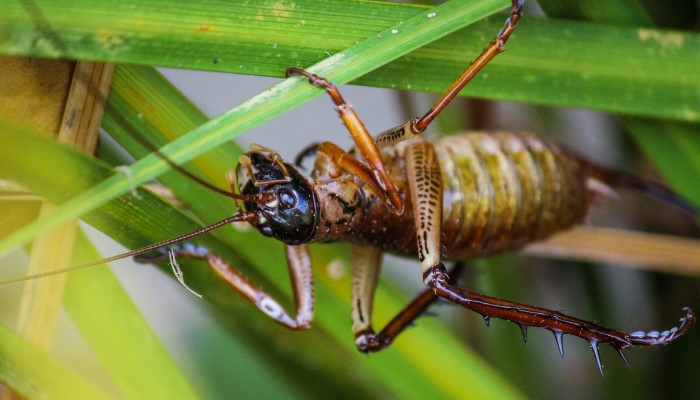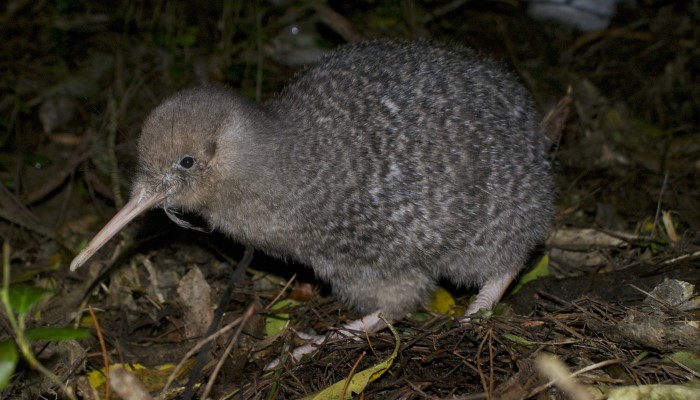Creepy-crawlies (New Zealand)
Where can I find information about creepy-crawlies of New Zealand?
(Years 5-8)

Image: Weta-1989 by Melodi2 on Wikimedia Commons.
Entry last updated: 10/07/25
Introduction
Aotearoa New Zealand is full of creepy crawlies, from the bush to the backyard. These include spiders, insects and other invertebrates (animals that don't have backbones). Some of these insects like the wētā and the huhu beetle are native to Aotearoa, while there are others like the painted apple moth are introduced species that have come from other countries. These introduced insects can be a threat to humans, wildlife, crops and native plants.
Types of creepy crawlies
Below is a list of well-known or unique creepy crawlies in New Zealand. If you are looking for an animal that is not on this list, you will still probably find information about it on the websites in this entry.
Daddy longlegs spider: This spider is also known as the cellar spider, and catches its prey in its messy webs.
Jumping spider: The jumping spider is known for its good eyesight. It pounces on its prey to catch it rather than using a web.
Katipō spider: This is the only poisonous New Zealand native spider and can be recognised by the red stripe down its black back.
Tunnelweb spider: This is one of the largest spiders in New Zealand. The tunnel-web spider gets its name from the silk-lined tunnels it makes under stones and logs, and eats any insect that gets caught.
White-tailed spider: The white-tailed spider was introduced from Australia. It likes to hide in houses and it has a painful bite!
Cicada: Cicadas live underground for three or more years before coming to the surface. It is only the male cicada that makes the loud noises you hear.
Cockroach: Cockroaches are quick and flightless. They love hanging around wood chips, or damp and dark areas.
Earwig: These bugs are nocturnal and use the pincers on their face to defend themselves.
Huhu beetle: This is a large bush insect that lives for only two weeks as an adult. As a grub, they chew up wood, and the grubs are perfectly edible!
Wētā: This flightless New Zealand native is large and spiny, and likes to live in dark, damp places. It looks like a large grasshopper.
Kauri snail: These snails are one of the few giant species of snail in New Zealand and can live up to 20 years. Many are now endangered or threatened.
Powelliphanta snail: This snail is the biggest snail in New Zealand, reaching around 9 cm across. Their shells are a mix of many beautiful colours.
Velvet worm: This worm looks similar to a caterpillar that lives on the forest floor. They are often called 'living fossils'.
General websites
The websites below will help you find information about creepy crawlies including their habitats, diets, anatomy, lifecycles, conservation and threats.
Department of Conservation (DOC)
The Department of Conservation is the government website about preserving the natural and historical sites of New Zealand.
Select Nature from the top of the page.
Go to Native Animals to find Invertebrates.
Find information about the flax snail and freshwater invertebrates.
Tips: We like sites that are from government or other reputable organisations, because we can trust the information. You can sometimes tell these sites by their web address – they might have .govt or .edu in their address – or by looking at their About us or Contact pages.
Te Ara: The Encyclopedia of New Zealand
Te Ara is an excellent starting point for all questions about Aotearoa New Zealand Aotearoa. If we look down to the bottom of the page we can see that the website belongs to the Ministry for Culture & Heritage.
Go to Topics and select either Insects or Invertebrates.
This will bring up a list of topics you can choose from eg Insects – overview and Snails and slugs.
Te aitanga pepeke – the insect world has pūrākau about insects.
Or you can search for a particular insect eg 'stick insects' or 'glow-worms'.
Tips: Like DOC, this website also has a .govt in their address which means they are from a government organisation, so the information will be reliable.
Manaaki Whenua Landcare Research: What is this bug?
Landcare Research is a Crown Research Institute website. This interactive has information about different creepy crawlies in Aotearoa.
Browse the list of bugs to find one you are interested in eg Copper butterfly.
Or, use the Search filters on the right side of the page.
Tips: Websites that have .com or .co in the address can have good information, but you need to assess how reliable it is. Check the About us link on the website, if you can find one. That can tell you what the company’s mission and values are.
Museum of New Zealand: Te Papa Collections
Collections Online have information on almost 800,000 artworks, objects and specimens from Te Papa’s collections. There’s also a wealth of information on related people, places, topics, species and research from Te Papa.
To search the website:
Enter the keyword 'spiders' into the search bar at the top of the page.
This will bring up a results about Spiders.
To make it easier to look through the results, select the sub-group Topic under the Type filter on the left-hand side.
Select What spider is that? to know more about Black tunnelweb spider, Avondale spider, Nelson cave spider and other spiders.
Tips: Search words, or keywords, are the most important words in our question. Usually it’s better to leave out small words like ‘the’, ‘a’ and ‘of’ and just choose the main ones, eg spiders. We can always change our keywords or add more if we need to.
Books
There are lots of books about creepy crawlies and where to find them. Check out your local public or school library to see what they have.
Some recommended titles:
All about New Zealand insects and other creepy-crawlies by Dave Gunson.
Which New Zealand insect? : with over 650 life-size photos of New Zealand insects by Andrew Crowe.
NZ bugs and critters by Dave Gunson.
New Zealand's backyard beasts by Ned Barraud.
What am I?. In the bush by Gillian and Darryl Torckler.
Te whānau weriweri by Marie Waaka.
SCIS no: 1870179
Topics covered
Related content

Native plants (NZ)
Where can I find information about the native plants of New Zealand?

Animals (New Zealand)
Where can I find information about animals in New Zealand?

Flight
Where can I find information about flight and how things fly?

Ecosystems (junior)
Where can I find information about ecosystems?

Food chains (junior)
Where can I find information about food chains?
